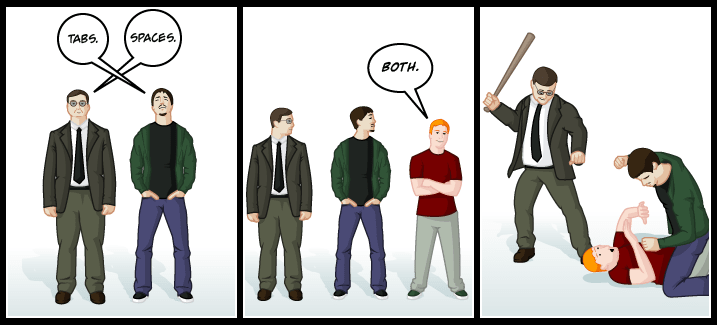If you are just starting to write programs and very likely you are getting the hang of your text editor of choice, then you may also find out that keeping a tidy code and reformatting old messy text can be tedious and involves removing your hands from the keyboard and reaching for the mouse more often that anyone would like.
Fortunately during my Programming journey, I have gather some tips that will be of help.
Become an expert in your main tool
A developer’s main tool is the humble Text Editor. In our careers, we spend a huge percentage of our time with that piece of software.

As in this already classic xkcd.com comic, real programmmers know how to use their text editor.
Not just how to open a file and type, but take your time to read the documentation, watch videos, make an effort in making those keybindings an instantaneous muscle-memory movement. Commands, plugins and every resource you can find, make it part of your arsenal.
On which editor to use? Well… That is enterily up to you. While I’m bias toward Vim; Atom, Visual Studio Code, Brackets, Notepad++, their main purpose is take care of changing bytes in a text file; learning the advanced functionality will pay huge dividends later on.
Read the style guide
A programming language’s style guide provides a series of guidelines on how to format your code. Just like in English, or any other human language, there is a governing set of grammatic rules that must be followed in order to be understood by everyone else.
All code in any code-base should look like a single person typed it, no matter how many people contributed.
— Source: codeburst.io
Like in graphic and UX design, getting acquainted with the style guide will help you in building good habits in writing software. This comes specially handy when you are starting to working with other developers.
One example that comes to mind is Python’s PEP-8. In Python, whitespace is very important as the interpreter wouldn’t run your program if your indentation is off. PEP-8 is a great reference for every aspiring and seasoned Python developer.
In JavaScript, there are many style guides, with the most popular ones being from AirBNB, Google and JavaScript Standard Style.
While Ruby’s syntactic sugar gives developers a unique freedom to writing code, Rubyists have a thorough resource in Rubocop’s Ruby Style Guide.
This Ruby style guide recommends best practices so that real-world Ruby programmers can write code that can be maintained by other real-world Ruby programmers
By following these style guides, we will be compliant with other member of the community, we make our code very readable to external readers and create good habits, making you a competent developer.
Use .editorconfig
In our careers, we are going to encounter other teammates or organizations that uses a different text editor or IDE that what we are used to. It’s not uncommon to see some people prefering Emacs, or Sublime Text, or maybe and IDE like RubyMine, as you might guess, configuring and setting each different tool makes for a headache an a half.

Well, Fear not as the .editorconfig project is an effort to consolidate the settings for formatting, indentation
Using a single text config file, your team/organization can set up everyone’s tools with the agreed settings like whether to use spaces or tabs, and other idiosincracies that may cause the code produced to be irregular.
Install linters and formatting helpers plugins
If you are not familiar with linters, they will either make your life easier or they will whine on how badly your code is formatted that it’ll make you feel down, and many days they will do both.
JSLint will hurt your feelings. Side effects may include headache, irritability, dizziness, snarkiness, stomach pain, defensiveness, dry mouth, cleaner code, and a reduced error rate.
— Douglas Crockford via the JSLint site
A linter is a piece of software that analyzes your code, and it gives you feedback about formatting errors, suspcious constructs and even bugs.
If you enjoy programming in JavaScript, or maybe not enjoy, but at least you don’t go insane while writing in it, you may have to give a shoutout to Douglas Crockford. During the times of the Web 2.0 and AJAX, Mr. Crockford authored a book called JavaScript: The Good Parts, which is an amazing book for when JavaScript was having even more terrible reputation; he would say that “JavaScript is a beautiful language if you avoid the bad parts”.
And to avoid those bad parts, he wrote JSLint in which the program would shout at you if you are using said “bad parts” of the language, and as he puts it…
JSLint was designed to reject code that some would consider to be perfectly fine. The reason for this is that JSLint’s purpose is to help produce programs that are free of error. That is difficult in any language and is especially hard in JavaScript
By the way, Douglas is also the creator of JSON file format, so you don’t have to be dealing with crazy XML response files.
Python and Ruby also have linters, with the popular ones being Flake8 and Rubocop, respectively.

Maybe the question in your mind is “How in the heck are you gonna be able to use those linters together with your text editor”.
Simple, plugins.
Good thing that programmers like to automatize every process they can get their hands on and this is no exception. If you google “linters” for your language plus your text editor, it is almost a safe bet that someone has your back.
Conclusion
Be an text editor Jedi, get familiar with the style guide of the language of your choice, and make use of linters to help you (hurt your feelings).
Now, I’m not going to go into the text editor wars or tell why editor X is better than editor Y. Let’s not waste our time, for we all can conclude that … Vim is the best editor!
 (See what I did there, wink wink…).
(See what I did there, wink wink…).
Cheers.
